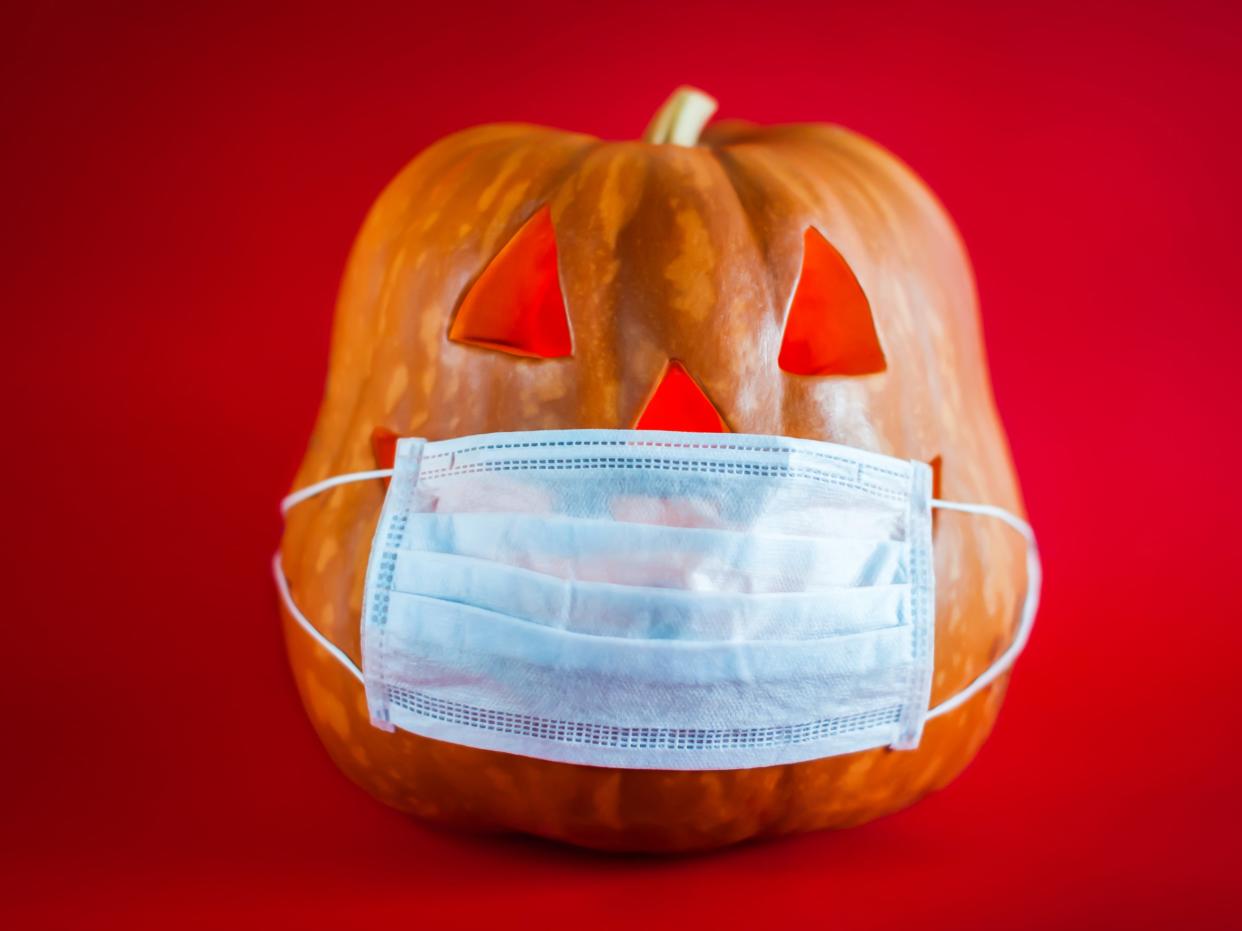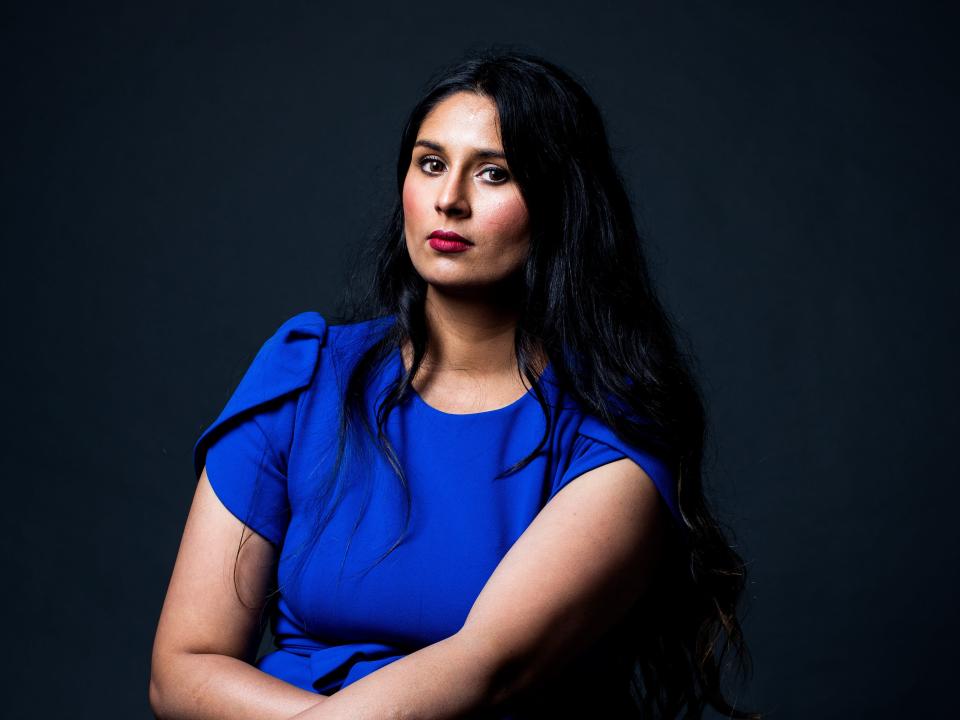How to celebrate Halloween with your kids while staying safe during COVID-19, according to an epidemiologist

Dr. Syra Madad is an infectious diseases epidemiologist in NYC. She's senior director of NYC Health + Hospitals System-wide Special Pathogens Program and fellow for the Harvard Kennedy School, Belfer Center for Science and International Affairs.
Halloween — and other fall and winter holidays — during a pandemic will look a little bit different.
For Halloween, Madad is planning on having a candy egg hunt in her house for her children.
For holidays like Thanksgiving and Christmas, one way to spend time with family and friends is merging social bubbles.
September is the time my two boys, ages four and six, begin to explore what they're going to be for Halloween.
Last year it was superheroes, Black Panther and Iron Man; the year before it was Buzz Lightyear. A couple of weeks ago, they asked to be superheroes again, and to have their new baby sister be Wonder Woman when they go trick-or-treating.
But this year's Halloween —or, for that matter, Thanksgiving and Christmas — won't be the same. Instead, we'll be practicing a socially-distanced holiday season.
To understand risk levels and activities that may pose a greater risk in terms of exposure, it's important to keep the three C's, or key factors to avoid: crowded places, close-contact settings with extended duration of interaction, and confined and enclosed spaces. The three C's are based on the modes of transmission of COVID-19, which can include contact, droplet, airborne, and fomite transmission — among others.

Traditionally, Halloween trick-or-treating is primarily an outdoor event, and we know outdoor events are much less riskier given better ventilation. But the activity also involves going to multiple homes and getting treats. For the purposes of this discussion, I'll focus on fomite transmission, as Halloween activities can involve not only coming into close contact with someone, but also getting a treat (e.g. candy).
If someone is infected with COVID-19, their respiratory secretions can contaminate surfaces or objects, creating fomites. Fomites can potentially transfer the virus to a new person. For example, an infected person with COVID-19 coughs or sneezes into their hands, and then proceeds to touch a bowl of candy to distribute or directly expels droplets into the bowl of candy. A new person touches the contaminated candy, then proceeds to touch their mucous membranes (eyes, nose, or mouth). Sounds scary? Well, this is much easier said than done; let's break it down a bit further.
First, fomite transmission is not the primary mode of COVID-19 spread — respiratory droplets and close-range aerosol transmission are.
Second, fomite transmission can potentially occur if there's enough viable SARS-COV-2 virus that can cause infection – but we still don't know the amount of virus, or viral load that can actually cause infection.
Third, the possibility of someone infected with COVID-19 expelling enough viable respiratory droplets on a treat and trick-or-treater, then touching that same area, followed by touching their mucous membranes is low (but not zero).
And fourth, with all this said and done, there are no specific reports which have shown direct fomite transmission. There's a lot we've learned about COVID-19 over the past eight months, but there's still a lot we still don't know.
So how best to keep up the Halloween spirit (no pun intended) but keep it socially-distanced?
For my family, I plan to do a Halloween candy egg hunt around our house. I've purchased multi-colored plastic eggs online. During my most recent grocery store trip I wandered into the holiday aisle where the Halloween spread is ready for the picking. I've purchased bite size candy and plan to hide the eggs around our backyard and inside our home, and have the kids find them in their Halloween costume.
For more "human contact," like celebrating the holidays with friends and families indoors for an extended period of time, another option is to merge social bubbles.
A social bubble is non-household contact(s) that can freely interact with one another indoors without social distancing or wearing a mask. These social bubbles play it safe by a set of agreed upon rules – they limit their social interactions outside the bubble and practice protective measures like wearing a mask and abiding by isolation and quarantine guidelines if a member has been exposed to or diagnosed with COVID-19.
While there's no hard and fast rule in terms of the number of people to have in a social bubble, the general guidance is less than 10-12, or less than two to three households. The higher the number of people, the greater the risk of potential exposure and transmission of COVID-19.
To merge social bubbles, the non-test-based approach is to quarantine for 14 days, the incubation period of COVID-19 prior to merging. Something else to take into account when merging social bubbles is that risk is not uniform. Some individuals are at higher risk of severe illness from COVID-19 based on their demographics, occupation, certain underlying health conditions, risk behaviors, and other determinants of health. Decisions to merge social bubbles should include individual risk factors and similar risk profiles.
It's also important to take local epidemiological risk conditions into context when merging social bubbles, like traveling from one area with a high rate of COVID-19 infections to an area with lower rates of COVID-19 infections, and the need to quarantine for 14 days after arrival.
To throw another wrench into the upcoming holidays, flu season will be upon us very soon.
This means that not only will there be ongoing COVID-19 activity, there will also be seasonal flu thrown into the mix. There are overlapping signs and symptoms of COVID-19 and seasonal influenza — making it harder to distinguish.
While there is some optimism the preventative measures being taken for COVID-19, like wearing a mask, keeping a distance from others, and washing hands often will also help reduce the rate of seasonal influenza activity, this is yet to be seen here in the United States. Regardless, the same general principles should apply when merging social bubbles.
Do keep in mind, while we're trying to minimize risk of exposure and still create that holiday spirit (pun was intended there) the risk will not be zero.
But it's not an all or nothing approach either. As we find ways to safely interact with family and friends through brief outdoor gatherings or masking and watching our distance indoors, or through these social bubbles for extended, indoor periods of time, we should tighten our protective measures in other ways.
This means we must prioritize and do trade-offs to try to minimize the risk of infection while adhering to safety measures (e.g. wearing a mask). Perhaps you want to get a haircut, go grocery shopping, and dine out with a friend. Every one of these interactions may include coming into contact with non-household members, potentially prolonged interactions, crowds, confined spaces, poor ventilation all of which can increase one's risk of infection.
Instead, prioritize which activities would be the least risky: outdoors vs. indoors, a restaurant with multiple diners vs. solo dinner with a friend, hair cut by appointment vs. walk in with multiple patrons. Do keep in mind it can take just one unsafe encounter to contract COVID-19.
Certainly, rapid, cheap, and highly accessible COVID-19 testing can be a gamechanger come holiday season. There's still a lot that can change between now and Thanksgiving and Christmas. But for now, I'm going to take it one holiday at a time and enjoy Halloween the socially-distant way.
This Business Insider article was originally published on September 16, 2020.
Read the original article on Business Insider


